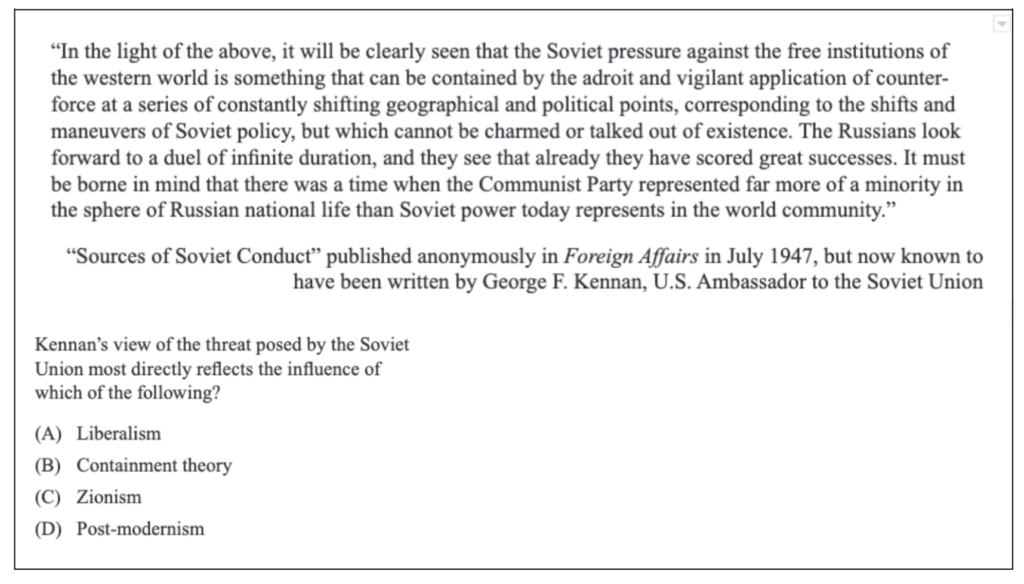by Emily Glankler
The Multiple-Choice Questions (or MCQ) are a strange beast in the AP History courses. They are the only part of the AP exam that is not free-response and teachers often struggle to give students clear strategies that apply to more than few MCQ on any given day. In my own classroom, I often treated MCQ as an obstacle we all had to get past: throw them on our unit exams and hope for the best so that we could spend class time on content and developing writing and reasoning skills.
But what if there was another way? I’ve found that we can use MCQ (and the hundreds of questions sitting in our AP Classroom Question Banks) not just as formative checks for understanding or summative assessments, but as tools to help our students improve their writing and reasoning.
I’ll be using the following MCQ from a Marco Learning practice test. (You can access more practice tests and lesson plans by signing up for Social Studies Teacher Support.)

Here are two short, simple activities that can be used to both practice MCQ while also hitting on higher level skills that are often difficult to simulate in the classroom.
Activity #1: A.P.E. the MCQ (Using MCQ to practice SAQ)d we approach the content of Unit 3?
First, a little background: I use the A.P.E. method for historical writing. (You can see it in detail here on my YouTube channel!) Other teachers use different acronyms (ACE; TEA; etc.) but they are all essentially the same approach to Short Answer Questions: students need to Answer the prompt, Prove it with evidence, and Explain their reasoning.
Now, consider that we can take almost any MCQ and reorganize it to mimic a written historical response. The question and correct answer become, well, the Answer or topic sentence. The stimulus provided contains at least some of the evidence needed to Prove the answer. And a students’ thought process as they figure out the correct answer is their internal Explanation.
The Activity
- Display an MCQ
- Ideally, choose a question that is tied to the stimulus provided rather than one that relies almost entirely on outside information.
- Make sure every student knows what the correct answer is and have them write out the question and the correct answer as a topic sentence.
- You can have them work through the MCQ first like normal, but just make sure everyone ends up with the correct answer choice.
- To speed things up, you can just tell them the correct answer up front.
- Ask students (or groups) to identify specific parts of the stimulus that could be used as evidence to support the correct answer. Have them write it out in their own words.
- This will be good practice later for using documents in a DBQ rather than just quoting or summarizing them.
- Finally, have students write out their reasoning in 1-2 sentences. Have them make the connection between the correct answer (which they already know) and the stimulus provided, plus any outside information or context that may be helpful.
For example, with the sample MCQ provided a student’s response might look something like this:
Kennan’s view of the threat posed by the Soviet Union most directly reflects the influence of containment theory. (Answer) In the passage, he specifically mentions the need to “contain” Soviet pressure against the freedoms of the western world and he warns that the Communist Party used to be a minority in Russia. (Evidence from the document) Kennan’s approach is pragmatic: he points out that the west cannot “talk [Communism] out of existence” but instead they need to apply constant “counterforce” whenever the Soviets try to “maneuver” their way into new regions. By pointing out that communism used to be not as popular in Russia, he is arguing that that could be the case again if the west is willing to contain it in a “duel of infinite duration” as the movement itself, hopefully, crumbles inside the Soviet Union. (Reasoning and analysis)
What’s the point?
This activity essentially is breaking down historical writing into its smallest parts. By giving students the correct answer in advance, and providing them with the evidence (in the form of the MCQ stimulus), they can focus all of their energy on the important skill of using evidence and explaining their historical reasoning in their own words. Basically, a good MCQ provides students with ⅔ of a good written response: the Answer and the Evidence (“hidden” somewhere in the stimulus plus, possibly, some outside information.) Students can start their written response with a ton of built-in support, allowing them (and you) to focus on the more difficult skills of explaining their analysis and reasoning in writing.
Activity #2: CED Scavenger Hunt
Background: I give my students a simplified version of the CED at the beginning of each unit. This serves as their unit outline and their exam review, while also getting them acclimated to the difficult language of the College Board.
This activity can be done with more than just the MCQ, but I find it’s a really helpful exercise that “demystifies” the MCQ by showing students that yes, in fact, every question is relevant to something we’ve learned (even though on the surface it might seem completely random.) This also can be helpful to show parents who might be surprised, especially early on, at raw test scores that are lower than what they are used to seeing in the gradebook.
The Activity
- Work through an MCQ so that students come to the correct answer.
- You could do this together as a class or this could be an activity for going over some of the most commonly missed questions on a quiz or test. Just make sure students are working with the correct answer.
- Ask students (or groups) to go on a “scavenger hunt” through this unit’s section in the CED and find every Historical Development that could be connected to the MCQ.
- Have students/groups share one Historical Development they connected to the MCQ. Here’s the key: they must be able to explain the connection in their own words.
- Some connections will be straightforward and won’t require too much explanation. This is the basic activity that will help struggling students see where each MCQ comes from and, possibly, how to better review for the next assessment.
- But the fun comes when students get creative. Once we’ve identified the more obvious Historical Developments connected to a question, I encourage my students to take creative leaps, as long as they can explain their reasoning. This practices a difficult skill of complex analysis: can students use everything they know about a topic to connect seemingly unconnected developments?
For example, the sample MCQ provided could be connected to the following Historical Developments in the AP US History curriculum:
8.2 The Cold War from 1945 to 1980
“Concerned by expansionist Communist ideology and Soviet repression, the United States sought to contain communism through a variety of measures, including major military engagements in Korea.”
Kennan’s argument is a response to US concern about the expansion of Communist ideology. The military engagement in Korea is an example of his containment theory because the US is responding to communist aggression (the North Korean invasion of the South) and applying “counterforce” to stop the expansion of the Soviet sphere (instead of going to war directly with the USSR, for example.)
8.5 Culture after 1945
“Mass culture became increasingly homogeneous in the postwar years, inspiring challenges to conformity by artists, intellectuals, and rebellious youth.”
By pointing out that Communism was once a small movement in Russia, Kennan is also supporting those at home who want to be vigilant against any possible sign of commmunist thinking amongst Americans. The fear of Communism spreading, both abroad and at home, led many Americans to embrace conformity as a sign of patriotism. Artists, intellectuals, and other communities like LGBTQ Americans were often labeled as “commmunist” when, in reality, they were just different from the approved “norm.” Many Americans viewed policing the views, attitudes, and expressions of their fellow citizens as their patriotic duty of “containment.”
Where can I find Multiple Choice Questions?
- AP Classroom Question Bank
- Marco Learning Teacher Support (lesson plan and practice test library)

Emily Glankler has taught almost every Social Studies course for the past decade from 6th grade World Cultures through AP® U.S. History but her favorite course to teach is AP® World History. She has taught AP® History courses at both private and public high schools in Austin, Texas and she was the team lead responsible for bringing AP® World (and building the curriculum from scratch) to the last two high schools where she has taught. Emily has also led professional development within Austin ISD as an Instructional Coach as well as presenting to an audience at SXSW EDU about incorporating current events into the core curriculum. She has a B.A. in History from the University of North Carolina at Chapel Hill and an M.A. in History from Texas State University. In addition to teaching full time, Emily also writes and produces a history podcast called Anti-Social Studies that is used by teachers and students in history classrooms around the country.
 Help
Help